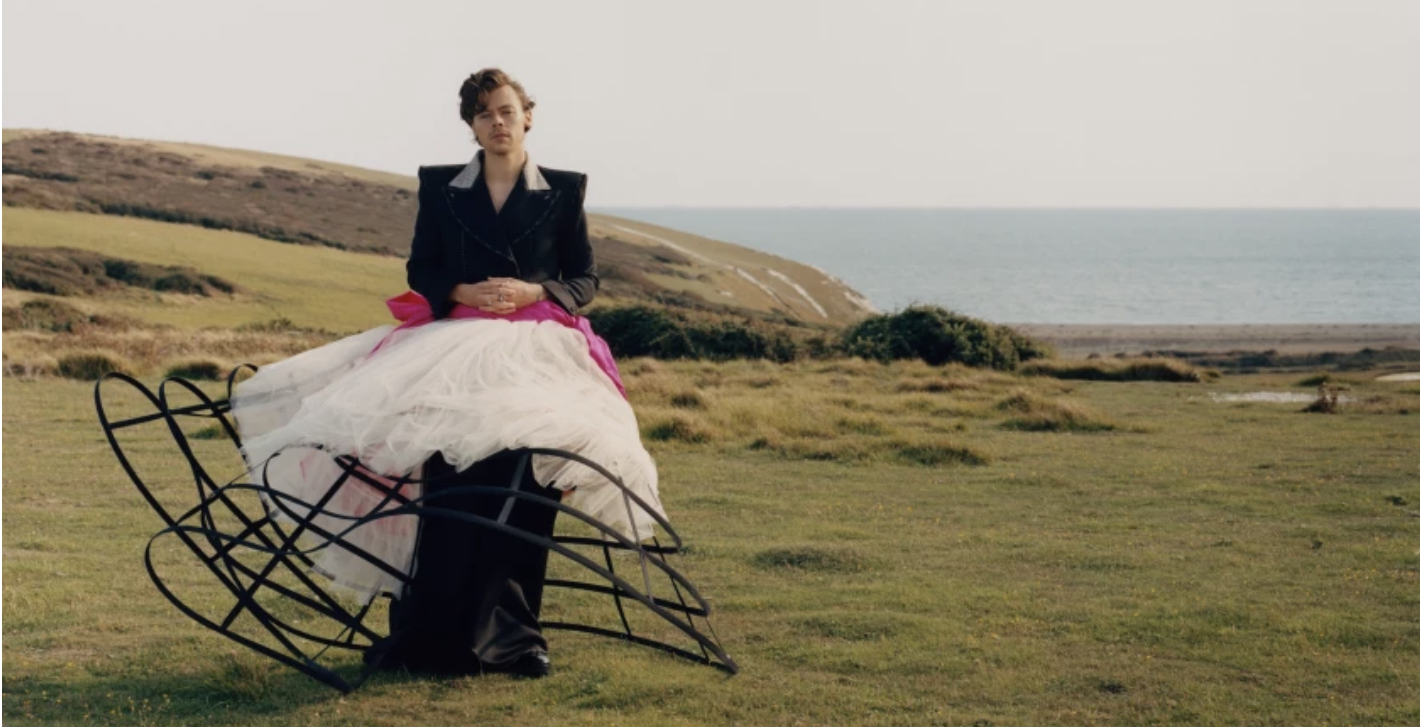Photo via Los Angeles Times
By Allie Cohen
Harry Styles has garnered much attention for making history as the first man to be on a solo cover of Vogue in their December 2020 issue, according to USA Today. Equally as notable, yet often overlooked, Styles also made history by sporting a dress as a man on a mainstream platform; marking a change in gender rigid norms. From Harry Styles to Lil Nas to Post Malone, men across the board have been increasingly adding dresses and skirts to their closets. This is fitting for a time when rigid gender norms and identities have become fluid, and the lines between gendered garments have become blurred. Yet, despite these great strides, men, particularly straight and cisgender men, wearing dresses and skirts are still seen as taboo. This is illustrated in a controversy with Kid Cudi, where he received backlash from people in the LGBTQ+ community for wearing a dress as a tribute to Kurt Cobain, as discussed in an article by The Conversation. Specifically, Kid Cudi is a cis-gender man, and some of the LGBTQ+ community “felt his choice was nothing but a ‘costume’ worn by a performer,” according to The Conversation. This is because trans people have faced criticism and violence for doing the same. Therefore, the LGQBTQ+ community, and particularly trans people, who have been the pioneers in gender nonconformity, felt that it was a double standard when contrasting the praise the rapper got, as stated in an article by The Guardian. Looking at this controversy prompts these questions: can straight, cis-gender men wear dresses without it being perceived as taboo or offensive? And why are certain items of clothing considered feminine or masculine?
The Pants Revolution
To understand the landscape of dresses, skirts, and gendered clothing, it’s important to look at the historical uses of these garments. According to the Daily Conversation, archeological evidence indicates that the first types of clothing were gender-neutral wrapped skirts and aprons. These clothes date back as early as 2900 BCE and were worn throughout ancient times by both men and women, as they were easy to make and permitted movement. Then, sometime between 3500 to 3000 BCE, horses became domesticated, leading to a need for a garment that would protect riders’ legs – the pants.
Pants became associated with men because horseback riding was an activity used for physically laborious and male-dominated responsibilities such as fighting and herding cattle. Before the creation of pants, the activities performed by men and women – e.g. farming, fighting, and building – were conducted comfortably in skirts. While pants became gendered due to their function, the introduction of tailoring in Europe in the 14th and 15th centuries made pants aesthetically masculine, as stated by Bustle.
Bloomer’s Trousers
It wasn’t until the 1850s that women began wearing trousers. The push to wear trousers was in response to the fact that the floor-length dresses and full skirts beneath tiny waists women were required to wear were not sustainable, according to Smithsonian Magazine. Specifically, to cater to such requirements, middle and upper-class American women had to fit themselves into corsets and six to eight petticoats to fill out the shape of their skirts – resulting in up to 15 pounds of added weight from clothes. In turn, the constricting clothing and rigid requirements for what women must wear posed significant health issues: “women complained of overheating and impaired breathing, sweeping along filthy streets and tripping over stairs, crushed organs from whalebone stays and laced corsets, and getting caught in factory machinery,” writes historian Annemarie Strassel. Aside from serious health problems, as America shifted to industrialization, women were working more outside of the home and in factories. Because of this, women needed garments that would allow more freedom of movement to conduct their duties in the factories. To address such concerns, a male editor of the Seneca County Courier wrote an editorial on women’s dress in which he suggested that women wear a combination of “Turkish pantaloons and a skirt reaching a little below the knee.” This garnered the attention of Amelia Bloomer, an editor of the first women’s newspaper, The Lily, who utilized the paper as a platform to advocate for the dress reform proposed by the courier man. This marked the revolution of gendered clothing reform.
Furthermore, although women began toying with the idea of wearing trousers as early as 1851, it wasn’t until over 100 years later that women were permitted to wear pants legally, and it wasn’t until recent decades that it was considered socially acceptable. This is reflected in the fact that it wasn’t until 2013 that women in Paris were allowed to wear pants under the law. Additionally, in America, when Carol Moseley-Braun [also Barbara Mikulski] wore pants on the Senate floor in 1993, it resulted in a silent uproar as there was an unspoken rule that women were not allowed to wear pants.
However, due to societal and economic changes such as the introduction of technological innovations, market substitutes, and home appliances, made the amount of time required for housework less, and thus caused a surge in women’s entrance into the workforce, as stated in Blau and Winkler’s The Economics of Women, Men, and Work. Marked by this entrance into the workforce, women began to take on more traditionally male roles, which in turn, made it more socially acceptable for women to wear trousers. Keeping this in mind, as women’s participation rates in the workforce continue to increase and men’s time spent on non-market (housework) labor also increases, the lines for gendered clothing may become more blurred as men’s and women’s roles and responsibilities also blur. Furthermore, when thinking about men and where they fit into the context of dresses, we need to look no further than at women’s tumultuous history with trousers.

